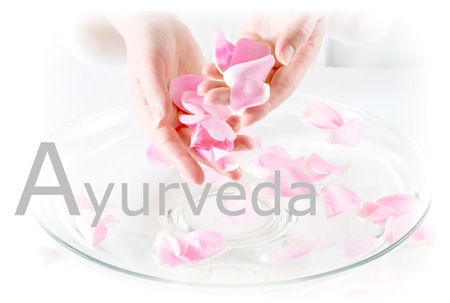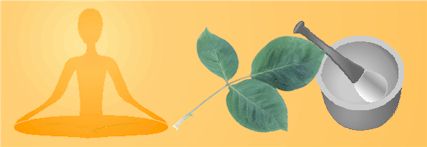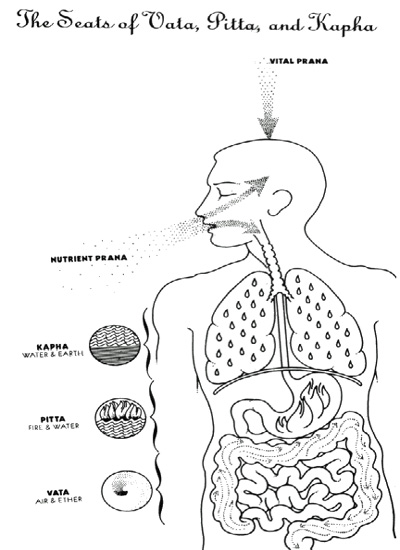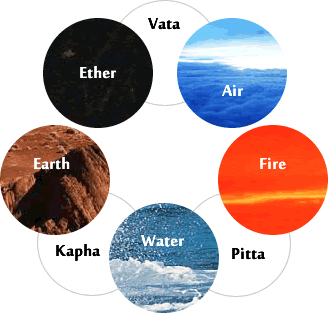


Ayurveda is the traditional Hindu science of medicine of long life that is practiced in one form or another by 80% of people of Indian descent. Around the Pacific rim, peoples from Fiji, Indonesia, Malasia and Singapore use Ayurveda practitioners when seeking help for physical and mental disorders.
Ayurveda like other forms of medicine is not just the reliance on past practices, but continues to be up-dated as more knowledge is known. Consider the term Ayurveda, which is a combination of dyus, meaning "life, vitality, health, longevity," (Crawford, l989, p. 3), and veda, meaning "science or knowledge (Crawford, l989, p. 3). Since 1947 the Indian government has regulated Ayurveda practices and Ayurveda medical colleges continue to train healers, publish papers and encourage research.
Thou, Agni, You are the Protector of the body; Protect my body.
Thou, Agni, Art the Bestower of long life; Bestow on me long life.
Thou, Agni, Art the Bestower of intellectual brilliance; Bestow on me intellectual brilliance.
Whatever, Agni, Is deficient in my body, make that complete for me.
Yojurveda Vs. 3.17
Qualified Ayurvedic Physicians have been are being registered as medical practitioners. Ayurvedic Colleges have been founded where theoretical and practical training is being imparted to students. A number of medical hospitals have been established where patients are being treated according to the Ayurvedic Science and practical lessons are being given to students. Ayurvedic manuscripts are being published, and books on Ayurvedic subjects Ayurvedic textbooks have also been published in different languages. Research work in theory and practice of Ayurveda is being conducted to some extent. Thus Ayurvedic studies have received a new impetus. (Kashikar, l977, p. XV)
It's purpose is summarized in the Sanskrit meaning of Ayurveda: ayus or life, vitality, health and longevity and veda or science and knowledge. The goal of Ayurveda is not just to heal, but to promote healthy living. Like many forms of Hindu healing, Ayurveda assists individuals to bring about a balance of the physical emotional and spiritual parts of self. The Vedas teach that people are not distinguished from other people or things - You and I have no separate existence, but exist in relationship to everything in the universe. These words of Mahatma Gandhi conceptualizes why Ayurveda is not only a form of healing, but a philosophy and way of life:
"The human body is the universe in miniature. That which cannot be found in the body is not to be found in the universe. Hence the philosopher’s formula, that the universe within reflects the universe without. It follows, therefore, that if our knowledge of our body could be perfect....we would know the universe."
Ayurveda is based on the early teachings in the Vedas, which are the core of Hindu scriptures. Thus Ayurveda is strongly influenced by the religious doctrines of Caraka and Susruta. These doctrines not only outline how a practitioner must conduct him or herself, but provides diagnostic methods to be followed. Ayurveda practitioners feel a strong affinity to the mythical and religious traditions in Hinduism. The world has to be viewed in its totality - the real and the imaginary. Yet the world is seen as a place of order, where nature's laws predominate, and humanity is in an endless cycle of birth, death, and rebirth. Karma, plays an important part of this view of the universe, but basically means that life will be influenced by what actions are taken in life. The authorship of early Ayurveda texts are unknown, thus reinforcing the sense of Ayurveda as being divinely inspired.
There are 8 branches of medicine in Ayurveda: internal, eyes, ears and throat, surgery, toxicology, emotional, pediatrics, rejuvenation, and aphrodisiacs. Philosophy and medicine have always gone hand-in-hand in India and is reflected in Ayurveda. This is important in that illness is not just physical manifestations, but psychological as well. For example, the philosopher Kapila says that the pot exists in the clay and the oil in the seed. Essentially, the foreground and background are always one and the same. The world is dualistic in which prakruti, the material principle, is pervasive.
Prakruti is composed of three elements called gunas: sattva, rajas, and tamas. These are the elements of pleasure, pain, and indifference. Sattva guna is the power to take action that brings happiness, lightness and illumination. Rajas guna is the power of mobility that brings about pain. Tamas guna is the power of indifference and confusion. These gunas are opposed to each other, yet they interact in all objects of the world. How one of the guna interacts over the others depends on the nature of a person or object. Purusa or self is the second principle in the dualistic system. The self is consciousness, but is different from the mind-body complex.
According to Crawford (1989):
At all times it is the subject of knowledge - never the object. Evolution commences when non-intelligent prakruti comes into contact with inactive purusa. The contact serves mutual purposes, analogous to the cooperation of a blind person and a lame person, trying to make their way out of a forest. The encounter shatters cosmic equilibrium, and the activated gunas contend with each other for predominance, combining in varied strengths, and thereby producing different objects in the world. . . Intellect has closest affinity to the transcendent, and in its pure (sattvika) state enjoys health and happiness; but vitiated by tamas, it becomes the ignorant prey of sorrow and disease. (p.14)
Throughout much of their history, the people from the South Asian sub-continent came into contact with the Persians, Greeks, and Chinese, with whom they exchanged information. About 900 BC the Ayurveda, written in India, combined descriptions of disease with information on herbs and magic. The first great Hindu physician known, Charaka, practiced about 1000 BC. Susruta, in the 5th century AD, noted the relationship of malaria to mosquitoes and of plague to rats, knew of more than 700 medicinal plants, and described more than 100 surgical instruments. He treated fractures, removed tumors and kidney stones, and delivered babies by Caesarian section.

An aspect of Prakruti is the ego or "mineness." This part of the five senses, five perceptions, five organs of actions and the mind. Another aspect of the ego are the five elements. However, it is the rajas that supplies the energy for the sattva and tamas to evolve. Essentially, individuals are pulled into different poles, yet these poles cooperate. These are divided into three natures: sattva (purity), rajas (passion), and tamas (darkness). These natures stand on their own, yet when working together they produce enlightenment. The example of a lamp epitomizes this dynamic interaction, because it contains fire, the wick, and oil, but combined these things form light. Yet each are separate and stand by themselves.
The goal of integrating the spirit, soul, and body is the only way to bring about healing. As such, the Ayurveda healer must consider all of these factors when dealing with a client. Individuals are a microcosm of the universe and contain the basic elements of space, air, fire, water and earth. The relationship between individuals and nature underlies Ayurveda. Yoga is an example of how individuals can bring about "balance" between the mind, body and spirit. In yoga, individuals are taught how to tune out the world and tune into the "pure" self consciousness within. What happens is a release of the transcendent spirit that is "free from all the pain, misery, and death characterized by physical existence" (Crawford, 1989, p. 15). Yoga provides a practical method of purification by helping individuals become morally strong, which is a prerequisite for spiritual discipline.
There are 8 steps of purification:
1) yama or the sensitivity to the quality of life in the body;
2) niyama or the sensitivity to the quality of life in the mind;
3) asana or postures that restore high levels of energy;
4) prayama or control of breathing (concentration enhanced);
5) and 6) kharana and dhyana or controlling the mind without using the body; and
7) samadhi or psychic powers that maintain the body's vitality.
Yoga relies heavily on discipline, particularly physical discipline. Yogis believe that it is only a fit body that can achieve spiritual well-being. Thus the ability to concentrate is necessary to preserve good health, because disease is a physical, mental and spiritual liability.

The life energy is called Prana, which activates the body and mind, and it manifests itself in the body as five elements: ether, air, fire, water, and earth. In the figure, the elements are arranged according to three basic principles: vata, pitta, and kapha.
Notice that each of these principles and elements affect different parts of the body as demonstrated: kapha (water & earth) the lungs area; pitta (fire & water) the stomach area; and vata (air & ether) the intestines.
However, notice that the body also is affected by the nutrients prana and vital prana. There is a cycle of interaction in all of these elements, body functions, environment, unconscious, and spiritual forces. You can even say there are types of people: vata types are thin, dry, cold and quick-moving, and tend towards fear and anxiety. Pitta types have a medium build, tend to be fair of skin and hair, and hot in body temperature. Kapha types are calm and solid, and their systems tend to be cold, oily, sluggish. These types are the three doshas (movement, metabolism and structure). People are a mix of types and what they do, eat, think, and so on reflects on how they interact with their world.
To understand how Ayurveda is practiced, it is important to know how the different external substances (Pancamahabhutas) of sound, touch, color, taste, and smell interact. Sound produces the Ether element. Ether, which figures prominently in Ayurveda, was formally thought to be the element that filled the upper regions of the earth, but is any organic compound characterized by the attachment of oxygen and carbon.
It is considered a cosmic substance that is in all people and things. The movement of touch combined with Ether produces air. The energy of color combined with the energies of sound and touch produce fire. The energy of taste combined with the essence of sound, touch and color produces water. Finally the energy of smell incorporates the qualities of sound, touch, color, taste and smell. These elements enter the body by eating and drinking and are in a continuous state of transformation. Only death ends the cycle.
In the body these elements form humors or dosas: wind, bile and phlegm. Wind (vata) comes from Ether and air. Bile (pitta) comes from fire and water. Phlegm or kapha comes from the earth and water. Along with blood, these humors sustain and regulate the body. When these humors are in balance, the body stays healthy and when they are out of balance the body becomes diseased. The dosas permeate the body, however, each has its own physical area. The kapha is centered in the navel, the pitta in the trunk and pelvis, while the vata is centered below the pelvic area.
Each dosa has 3 stages: aggravation (expansion), diminutive (contraction), and equilibrium. Thus the Ayurveda healer must have a thorough understanding of the dosas. Wind (body air) is called the kapha, the combination of air and Ether, is the most important of the humors. It regulates respiration, circulation, etc. Hypertension pain, stiffness and cardiac dysfunction result when there is a loss of balance.
This can be aggravated by eating to much or eating the wrong kind of food, too much strain, sleeplessness, etc. Not surprisingly, the emphasis on breathing is paramount in Ayurveda. There are 5 kinds of air that regulate well-being. When these are out of balance, illness sets in. Bile brings heat, called the pitta, is composed of fire and earth. It controls the hormones and affects all physical function, such as digestion and metabolism.
The third humor is phlegm (Ether and water), which regulates the other two humors. The time of day regulates the humors and thus the cycle of life or the changing of the seasons is reflected in the humors. In the morning phlegm predominates, while at mid-day bile are strongest and in the evening, wind predominates.
In early life or the growing years, kapha concerns the body processes. In adulthood, pitta controls, while in the declining years vata predominates. In addition, all people have a predominate disposition of the humors, which need to be taken into account in treating individuals.
According to the Ayurveda Foundation, if you answer yes to these questions, then Ayurveda can help you.
Ayurveda sees that the two main areas that affect our health and wellness are the foods we eat and the lifestyle we live. By changing our nutritional protocol and lifestyle, we can greatly influence our physical, mental, and emotional health. If you're having difficulty remembering things or acquiring a good night's sleep, this can be caused by an overly-active mind or too much stress in one's life.
Ayurveda suggests that you bring more regularity to activities such as the time you eat your meals and when you go to bed. You can also give yourself a warm oil massage before bathing. Create time in your schedule to relax and have some fun- for example, take a leisurely walk or get out in nature. These are just a few suggestions that represent a Vata pacifying program.
Digestive disorders are most commonly caused by eating foods that don't support us such as fermented, heavy, or excessively rich foods and/or foods that are either too spicy, sour or salty. By eating lighter foods that are easier to digest, avoiding processed foods, and avoiding ice cold beverages you can resolve many digestive problems. Ayurveda says that following a Pitta pacifying program is a good way to bring relief to our digestive system.
How about low energy? Being overly stimulated can result in the depletion of your energy level (called "burnout" in the west). Ayurveda suggests getting more sleep. Bringing more regularity to your diet and lifestyle can greatly improve your energy level. In addition calming our mind can also be a great help. This can be done by simply taking a few minutes a day to sit calmly and relax while taking long, full, deep breaths. Ayurveda also sees the need to have an adequate amount of good healthy fun in one's life to help keep us happy. Avoid excessive amounts of caffeine and alcohol which cause burn out. Instead, try getting to sleep earlier, and you'll wake up with more energy. Another suggestion is to follow a Vata reducing protocol.
Skin problems are a result of excessively oily skin and too much heat in the body. Foods that are deep fried or overly spicy can create skin eruptions. Not taking proper precautions against the rays of the sun will also aggravate the skin. Certain harsh, abrasive chemicals and synthetic fibers can adversely affect the skin so try to wear natural fabrics like cotton, wool, and silk. Whenever possible protect your self from exposure to toxic chemicals. Ayurveda sees that certain foods like white rice, watermelon, and coriander can alleviate many skin problems.
 A practitioner of Ayurveda follow the Caraka, which states that a person must know the vedas, be knowledgeable about the environment and understand human nature. Self centered people cannot be perceptive, nor can they articulate diagnosis and the treatment of Ayurveda. Thus, being balanced and open are as important to healing as having intelligence. Being able to diagnose diseases is vital to treating those diseases properly, thus categorizing an illness in terms of their origins takes up the initial phase of the healing process.
A practitioner of Ayurveda follow the Caraka, which states that a person must know the vedas, be knowledgeable about the environment and understand human nature. Self centered people cannot be perceptive, nor can they articulate diagnosis and the treatment of Ayurveda. Thus, being balanced and open are as important to healing as having intelligence. Being able to diagnose diseases is vital to treating those diseases properly, thus categorizing an illness in terms of their origins takes up the initial phase of the healing process.
In the diagnosis, there are four categories of diseases: external, internal, mental and natural. Factors responsible for the imbalance of the humors are divided into 3 divisions: external, internal and supernatural. External causes of diseases can be due to the changing of the seasons or a snake bite. Internal causes come out of the imbalance of the mind and body. The super-natural can be caused by the unknown (God) or hunger, thirst, senility, etc. In the initial stages, the medical model is followed, and clients are passive and receptive.
In diagnosing, the practitioner must be guided by exploring the etiology, symptoms, and prognosis of the disease. This is obtained by 3 sources of knowledge: learning gained from the vedas, direct observation of people and the world, and the ability to make inferences on what is known and observed (past and present). Drugs or herbal medicines are commonly used to treat diseases and correct imbalances. However, the practitioner must not just be concerned with the physical, but the mental and spiritual aspects of the client.
On the physical level the concern is with the causes of illness, including toxic and pathological reactions. For example, a physical imbalance can be caused by the absence of a certain mineral, which a herb can remedy. On a mental level, the client can be educated and provided with a course of action that will lead to a healthier life style (e.g. Yoga or dietary counseling). Exercises and various actions are prescribed, making the treatment at this stage proactive.
Finally, on a spiritual level, the client is encouraged to become a better person by living in harmony with the environment and seeking ultimate truth or salvation. A practitioner can use guidance, medicines, and even surgery. Guidance can consist of giving advice on taking care of the body, eating properly, exercising and thinking positively.
On the surface, Ayurveda may appear to the Westerner as esoteric, having more to do with Hinduism than medicine, or have a primitive less scientific structure. Yet, Ayurveda has withstood centuries of practice in a part of the world which has few Western trained doctors and resources. With its emphasis on the whole person Ayurveda adds elements of healing that are not found in Western medicine. Perhaps it is its longevity, whole person outlook, and emphasis on the spirituality that Westerners should pay attention to.
According to Crawford (1989) there are three implications to the core of Ayurveda healing:
1) the body cannot be cured without considering the relationship of the body and mind
2) spirituality can never be separated from personal development
3) the spiritual well-being of individuals promotes physical well-being
In the end, a healthy life style is only a reflection of how individuals perceive their world, yet it is in how they act in accordance with their perceptions that really matters. Healthy living is not just thinking about it, but doing what is personally morally beneficial to the planet as a whole. Thus, individuals must always keep the purpose of their existence and the manner in which they act in the forefront of their struggle to live a balanced and meaningful life. For all humanity, it is how they act in life that determines how they will live and prosper. A positive energy source, provided by living in balance or in harmony with all things, produces happiness, a healthy life style, and a positive optimistic outlook.
According to Crawford (1989) Ayurveda essentially ". . .values the primacy of the spirit [and] health is valued as an indispensable means to that goal. Health may not be everything, but everything without health is nothing." (p. 31)
Author: Honoré France
References
Crawford, C. (1989) Ayurveda: The science of long life in contemporary perspective, in A Sheikh & K. Sheikh's Eastern & Western approaches to healing (eds), NY: John Wiley & Sons.
Source Here
© CrystalWind.ca 2024. All content (articles, imagery, fair use) & design protected. Written permission required for copying. All rights reserved.
Join the Conversation Now! Comment Below! ![]()
© 2008-2024 CrystalWind.ca. All rights reserved. Site Creation by CrystalWind.ca.
Web Hosting by Knownhost.com